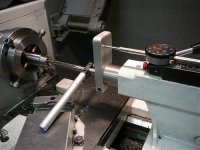M
mpatti
Guest
I recently purchased the Grizzly 4003G. I noticed that barrels that are around 20 inches are too short to make it through the headstock to the spider gear. On this site, I have read that some people chamber in the steady rest between centers. I am curious how you chamber between centers because I feel limited that my lathe can only work on longer barrels ,24 inches or so, through the headstock.
Can anyone describe this or recommend a good book on this??
Can anyone describe this or recommend a good book on this??


